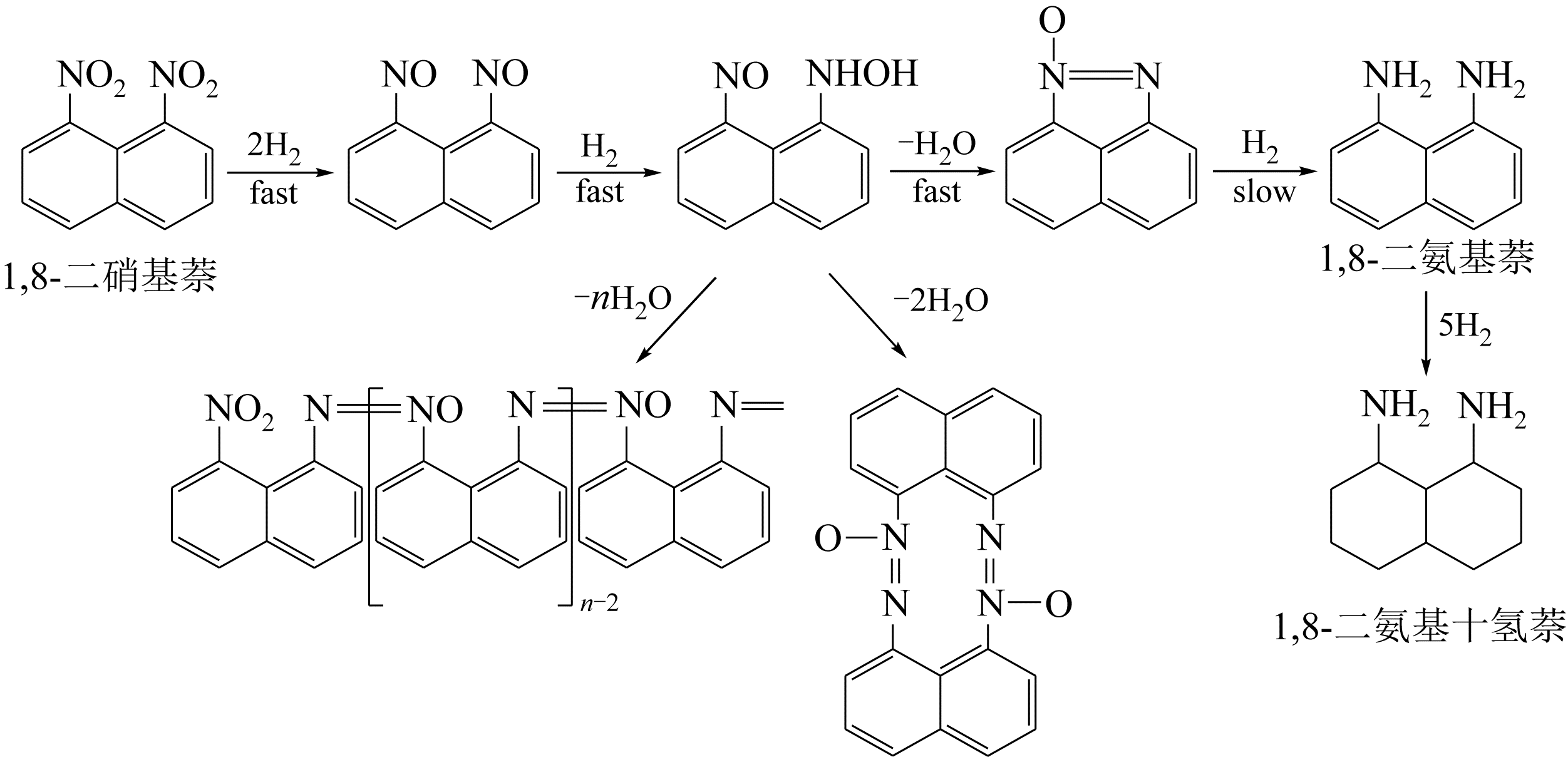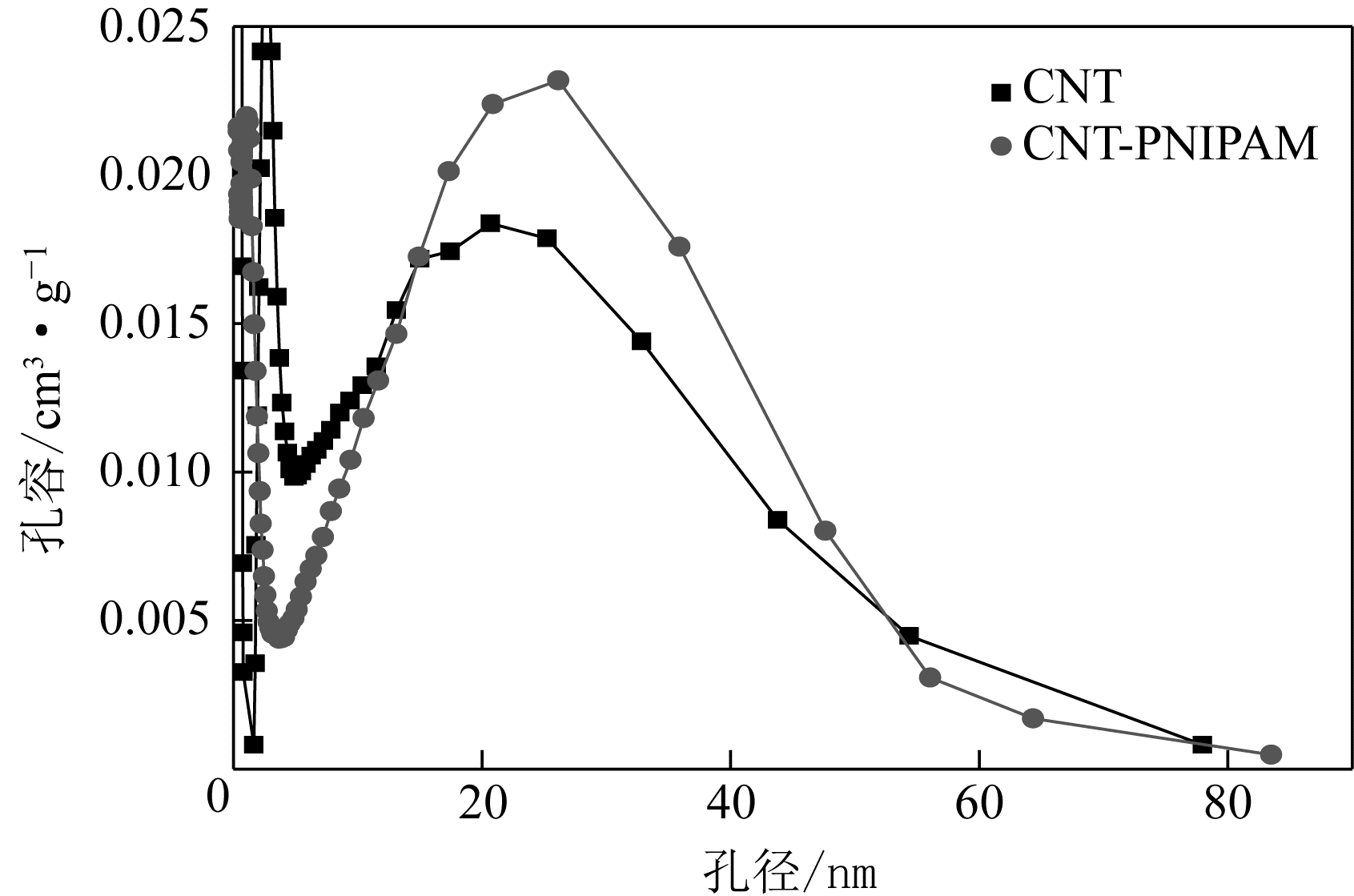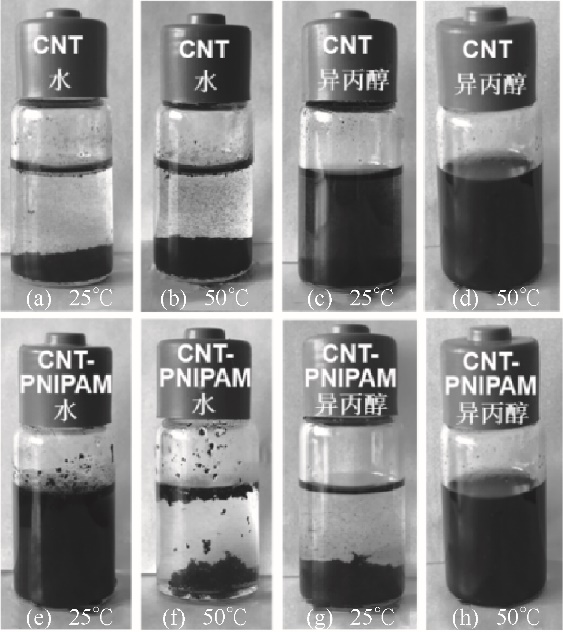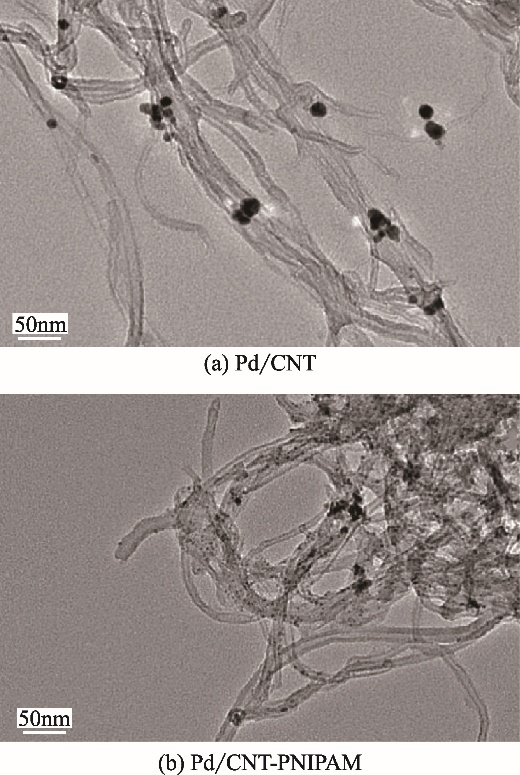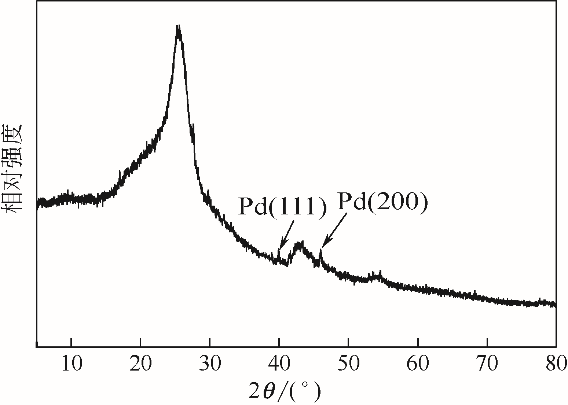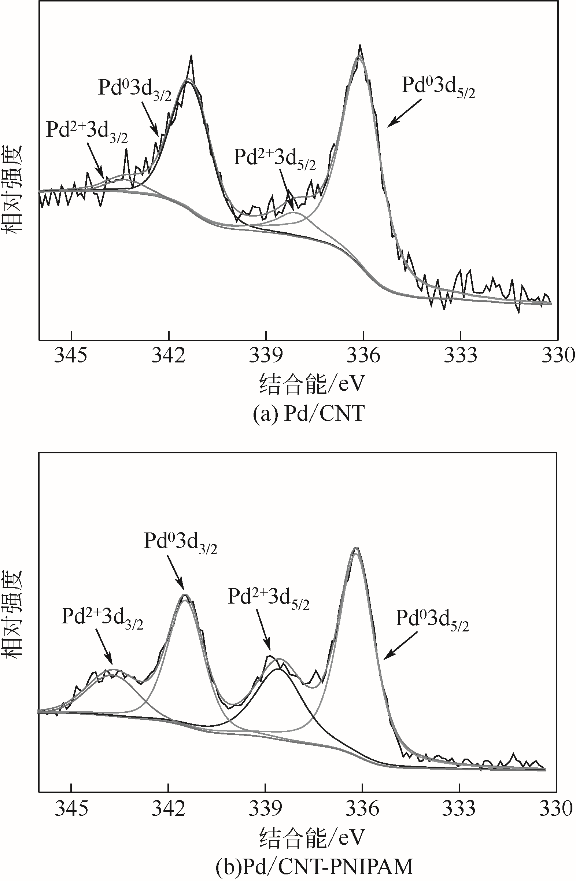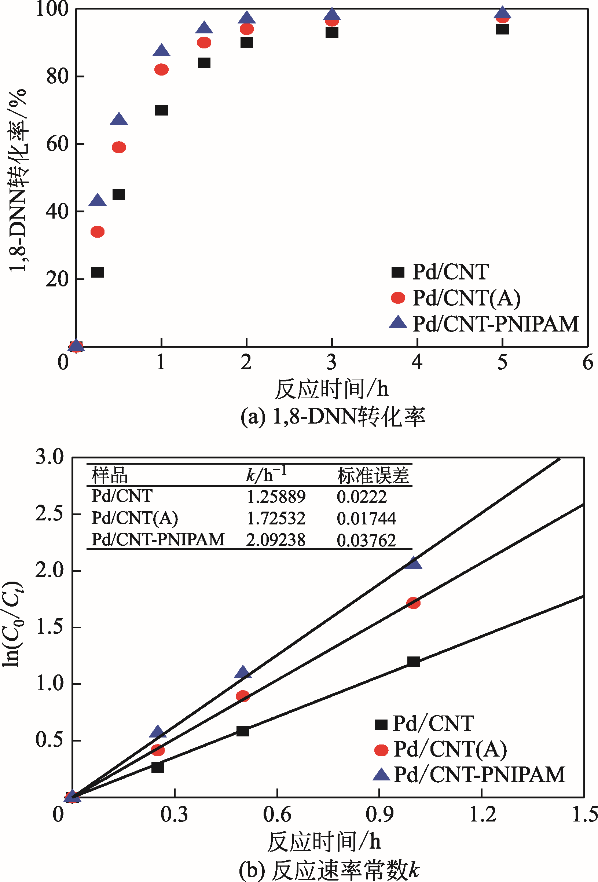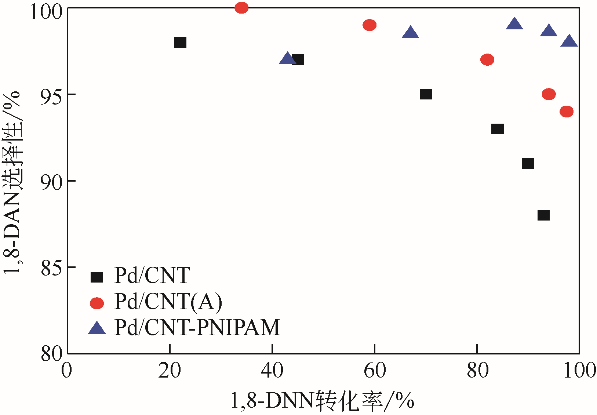化工进展 ›› 2020, Vol. 39 ›› Issue (1): 181-189.DOI: 10.16085/j.issn.1000-6613.2019-0218
表面润湿性可控的碳纳米管负载钯催化剂及其在1,8-二硝基萘选择性加氢中的催化性能
窦梦迪1,2( ),丁雪洁1,2,刘雯欣1,2,张伟1,2,鲁墨弘1,2,李明时1,2,朱劼1,2(
),丁雪洁1,2,刘雯欣1,2,张伟1,2,鲁墨弘1,2,李明时1,2,朱劼1,2( )
)
- 1. 江苏省绿色催化材料与技术重点实验室,江苏 常州 213164
2. 常州大学石油化工学院,江苏 常州 213164
-
收稿日期:2019-02-14出版日期:2020-01-05发布日期:2020-01-14 -
通讯作者:朱劼 -
作者简介:窦梦迪(1994—),女,硕士研究生,研究方向为工业催化。E-mail:1361112460@qq.com 。 -
基金资助:国家自然科学基金(21676029);江苏高校优势学科建设工程项目
Carbon nanotubes supported palladium catalyst with wettability controllable surface and its catalytic performance in selective hydrogenation of 1,8-dinitronaphthalene
Mengdi DOU1,2( ),Xuejie DING1,2,Wenxin LIU1,2,Wei ZHANG1,2,Mohong LU1,2,Mingshi LI1,2,Jie ZHU1,2(
),Xuejie DING1,2,Wenxin LIU1,2,Wei ZHANG1,2,Mohong LU1,2,Mingshi LI1,2,Jie ZHU1,2( )
)
- 1. Jiangsu Key Laboratory of Advanced Catalytic Materials and Technology, Changzhou 213164, Jiangsu, China
2. School of Petrochemical Engineering, Changzhou University, Changzhou 213164, Jiangsu, China
-
Received:2019-02-14Online:2020-01-05Published:2020-01-14 -
Contact:Jie ZHU
摘要:
首先通过原子转移自由基聚合技术(atom transfer radical polymerization,ATRP)在碳纳米管(CNT)表面接枝聚N-异丙基丙烯酰胺(PNIPAM),成功制备出表面润湿性可控的复合载体(CNT-PNIPAM),并以其为载体制备Pd催化剂(Pd/CNT-PNIPAM)。采用红外光谱仪(FTIR)、热重仪(TGA)、有机元素分析仪(OEA)、差示量热仪(DSC)、X射线衍射仪(XRD)、透射电镜(TEM)和N2吸附等手段对材料进行表征。制备的催化剂用于1,8-二硝基萘(1,8-DNN)选择性加氢反应,并研究表面化学对催化性能的影响。结果表明,CNT-PNIPAM的最低临界溶液温度(LCST)为37℃左右。利用温敏效应,CNT-PNIPAM在25℃(<LCST)下负载Pd纳米颗粒,粒径为3.6nm±0.8nm。载体在低温下的亲水表面提高了Pd纳米颗粒在其上的分散。Pd/CNT-PNIPAM在120℃ (>LCST)下表面润湿性发生转换。PNIPAM接枝引起催化剂表面化学性质的变化,进而使其对底物的吸附性能发生改变。Pd/CNT-PNIPAM上Pd颗粒的高度分散及其对1,8-DNN优良的吸附性能不仅使催化活性得以提高(反应速率常数k=2.1h-1),而且对1,8-DAN的选择性也更高(完全反应时1,8-DAN选择性达98%)。
中图分类号:
引用本文
窦梦迪,丁雪洁,刘雯欣,张伟,鲁墨弘,李明时,朱劼. 表面润湿性可控的碳纳米管负载钯催化剂及其在1,8-二硝基萘选择性加氢中的催化性能[J]. 化工进展, 2020, 39(1): 181-189.
Mengdi DOU,Xuejie DING,Wenxin LIU,Wei ZHANG,Mohong LU,Mingshi LI,Jie ZHU. Carbon nanotubes supported palladium catalyst with wettability controllable surface and its catalytic performance in selective hydrogenation of 1,8-dinitronaphthalene[J]. Chemical Industry and Engineering Progress, 2020, 39(1): 181-189.
| 样品 | C/% | H/% | N/% | PNIPAM/% |
|---|---|---|---|---|
| CNT | 96.37 | 0.32 | — | — |
| CNT-PNIPAM | 77.45 | 2.45 | 2.73 | 31.0 |
表1 CNT材料有机元素分析
| 样品 | C/% | H/% | N/% | PNIPAM/% |
|---|---|---|---|---|
| CNT | 96.37 | 0.32 | — | — |
| CNT-PNIPAM | 77.45 | 2.45 | 2.73 | 31.0 |
| 样品 | BET比表面积/m2·g-1 | 孔容/cm3·g-1 | 平均孔径/nm |
|---|---|---|---|
| CNT | 217 | 0.71 | 13.1 |
| CNT-A | 221 | 0.77 | 14.5 |
| CNT-PNIPAM | 169 | 0.76 | 18.2 |
表2 CNT改性前后的结构特性
| 样品 | BET比表面积/m2·g-1 | 孔容/cm3·g-1 | 平均孔径/nm |
|---|---|---|---|
| CNT | 217 | 0.71 | 13.1 |
| CNT-A | 221 | 0.77 | 14.5 |
| CNT-PNIPAM | 169 | 0.76 | 18.2 |
| 样品 | Pd负载量①/% | Pd纳米颗粒粒径②/nm | Pd分散度③/% |
|---|---|---|---|
| Pd/CNT | 1.02 | 10.7±3.0 | 12.1±3.5 |
| Pd/CNT-A | 0.96 | 4.6±0.8 | 26.2±3.6 |
| Pd/CNT-PNIPAM | 1.04 | 3.6±0.8 | 34.9±7.8 |
表3 Pd催化剂性质
| 样品 | Pd负载量①/% | Pd纳米颗粒粒径②/nm | Pd分散度③/% |
|---|---|---|---|
| Pd/CNT | 1.02 | 10.7±3.0 | 12.1±3.5 |
| Pd/CNT-A | 0.96 | 4.6±0.8 | 26.2±3.6 |
| Pd/CNT-PNIPAM | 1.04 | 3.6±0.8 | 34.9±7.8 |
| 样品 | 转化率/% | 选择性/% | 收率/% |
|---|---|---|---|
| CNT-PNIPAM-R1 | 98.82 | 97.68 | 96.53 |
| CNT-PNIPAM-R2 | 94.26 | 96.92 | 91.36 |
| CNT-PNIPAM-R3 | 84.50 | 97.36 | 82.27 |
表4 CNT-PNIPAM重复结果的催化性能
| 样品 | 转化率/% | 选择性/% | 收率/% |
|---|---|---|---|
| CNT-PNIPAM-R1 | 98.82 | 97.68 | 96.53 |
| CNT-PNIPAM-R2 | 94.26 | 96.92 | 91.36 |
| CNT-PNIPAM-R3 | 84.50 | 97.36 | 82.27 |
| 1 | 刘树文 . 合成香料技术手册[M]. 北京: 中国轻工业出版社, 2000: 13-107, 160-243. |
| LIU S W . Synthetic spice technical manual[M]. Beijing: China Light Industry Press, 2000: 13-107, 160-243. | |
| 2 | 许关煜 . 医药中间体手册(上册)[M]. 北京: 化学工业出版社, 2000: 53, 202, 250. |
| XU G Y . Handbook of pharmaceutical intermediates (volume 1)[M]. Beijing: Chemical Industry Press, 2000: 53, 202, 250. | |
| 3 | GALLEZOT P , RICHARD D . Selective hydrogenation of alpha beta-unsaturated aldehydes[J]. Catalysis Reviews: Science and Engineering, 1998, 40 (1/2): 81-126. |
| 4 | 唐坤 . 中间体化学工艺学[M]. 北京: 化学工业出版社, 1984: 153-186. |
| TANG K . Intermediate chemical technology[M]. Beijing: Chemical Industry Press, 1984: 153-186. | |
| 5 | 奚若明, 张明国 . 中国化工医药产品大全(第一卷)[M]. 北京: 科学出版社, 1991: 197. |
| XI R M , ZHANG M G . China chemical and pharmaceutical products encyclopedia (volume I)[M]. Beijing: Science Press, 1991: 197. | |
| 6 | 徐克勋 . 精细有机化工原料及中间体手册(3)[M]. 北京: 化学工业出版社, 1998: 151-161. |
| XU K X . Handbook of fine organic chemical materials and intermediates (3)[M]. Beijing: Chemical Industry Press, 1998: 151-161. | |
| 7 | 任勇, 刘静, 华维一 . 3-氯-1-苯丙稀合成工艺研究[J]. 中国药物化学杂志, 1997, 7(3): 215-217. |
| REN Y , LIU J , HUA W Y . Study on the synthesis of 3-chloro-1-phenylpropene[J]. Chinese Journal of Medicinal Chemistry, 1997, 7(3): 215-217. | |
| 8 | 邱志刚, 袁红霞 . 一种用于1,8-二硝基萘催化加氢制备1,8-二氨基萘的催化剂及其制备方法: CN102430416A[P]. 2012-05-02. |
| QIU Z G , YUAN H X . A catalyst for the preparation of 1,8-diaminonaphthalene by catalytic hydrogenation of 1,8-dinitronaphthalene and its preparation method: CN102430416A[P]. 2012-05-02. | |
| 9 | 罗和安, 刘平乐, 刘丽娜, 等 . 一种1,5-二硝基萘加氢催化剂及其制备方法和应用: CN102172528A[P]. 2011-09-07. |
| LUO H A , LIU P L , LIU L N , et al . 1,5-dinitronaphthalene hydrogenation catalyst and its preparation method and application: CN102172528A[P]. 2011-09-07. | |
| 10 | 倪伟, 汪学广, 盛瑶, 等 . 一种1,8-二硝基萘加氢催化剂及其制备方法: CN108686652A[P]. 2018-10-23. |
| NI W , WANG X G , SHENG Y , et al . A 1,8-dinitronaphthalene hydrogenation catalyst and its preparation method: CN108686652A[P]. 2018-10-23. | |
| 11 | 刘平乐, 熊伟, 郝芳, 等 . 一种无金属加氢催化剂及其催化1,5-二硝基萘加氢反应的应用: CN105749954A[P]. 2016-07-13. |
| LIU P L , XIONG W , HAO F , et al . A metal-free hydrogenation catalyst and its application for the hydrogenation of 1,5-dinitronaphthalene: CN105749954A[P]. 2016-07-13. | |
| 12 | 张伟, 孙建芝, 李明时, 等 . 一种二硝基萘催化加氢制备二氨基萘的方法: CN101575295[P]. 2009-11-11. |
| ZHANG W , SUN J Z , LI M S , et al . A method for the preparation of diaminonaphthalene by catalytic hydrogenation of dinitronaphthalene: CN101575295[P]. 2009-11-11. | |
| 13 | 陈根生, 郜磊, 沙玲 . 1,5-和1,8-二氨基萘的合成方法及应用[J]. 河南化工, 1998(2): 35-36. |
| CHEN G S , ZHAI L , SHA L . Synthesis and application of 1,5- and 1,8-diaminonaphthalene[J]. Journal of Henan Chemical Industry, 1998(2): 35-36. | |
| 14 | 严生虎, 李彦飞, 张跃, 等 . 1,5‑二硝基萘加氢催化剂的制备方法及应用: CN106238099A[P]. 2016-12-21. |
| YAN S H , LI Y F , ZHANG Y , et al . Preparation method and application of 1,5-dinitronaphthalene hydrogenation catalyst: CN106238099A[P]. 2016-12-21. | |
| 15 | XIONG W , WANG K J , LIU X W , et al . 1,5-Dinitronaphthalene hydrogenation to 1,5-diaminonaphthaleneover carbon nanotube supported non-noble metal catalysts undermild conditions[J]. Applied Catalysis A: General, 2016, 514: 126-134. |
| 16 | ZAERA F . The surface chemistry of metal-based hydrogenation catalysis[J]. ACS Catalysis, 2017, 7: 4947-4967. |
| 17 | 张文斌 . 掺氮碳纳米管的制备及其催化硝基化合物加氢性能研究[D]. 湘潭: 湘潭大学, 2017. |
| ZHANG W B . Nitrogen-doped carbon nanotubes preparation and their catalytic performance in nitro compounds hydrogenation reaction [D]. Xiangtan: Xiangtan University, 2017. | |
| 18 | KOZLOV A L , ZBARSKIJ V L , KHODOV N V , et al . Highly-porous honeycomb catalyst for processes of liquid-phase hydration: RU2333795C2[P]. 2008-09-20. |
| 19 | WOLF F , FISCHER H . Catalytic reduction of aromatic vitro compounds on noble metal-carbon support catalysts in the liquid phase. Ⅱ. Catalytic reduction of substituted aromatic vitro compounds [J]. Journal fuer Praktische Chemie (Leipzig), 1975, 317(2): 241-246. |
| 20 | WANG Y , RONG Z , WANG Y , et al . Ruthenium nanoparticles loaded on functionalized graphene for liquid-phase hydrogenation of fine chemicals: comparison with carbon nanotube[J]. Journal of Catalysis, 2016, 333: 8-16. |
| 21 | SUN Z , RONG Z , WANG Y , al te . Selective hydrogenation of cinnamaldehyde over Pt nanoparticles deposited on reduced graphene oxide[J]. RSC Advances, 2014, 4: 1874-1878. |
| 22 | JI X , NIU X , LI B , et al . Selective hydrogenation of cinnamaldehyde to cinnamal alcohol over platinum/graphene catalysts[J]. ChemCatChem, 2014, 6: 3246-3253. |
| 23 | GARCÍA-BORDEJÉ E , LIU Y , SU D S , et al . Hierarchically structured reactors containing nanocarbons for intensification of chemical reactions[J]. Journal of Materials Chemistry A, 2017, 5: 22408-22441. |
| 24 | TOEBES M L , NIJHUIS T A , HÁJEK J , et al . Support effects in hydrogenation of cinnamaldehyde over carbon nanofiber-supported platinum catalysts: kinetic modeling[J]. Chemical Engineering Science, 2005, 60: 5682-5695. |
| 25 | JUNG A , JESS A , SCHUBERT T , et al . Performance of carbon nanomaterial (nanotubes and nanofibres) supported platinum and palladium catalysts for the hydrogenation of cinnamaldehyde and of 1-octyne[J]. Applied Catalysis A: General, 2009, 362: 95-105. |
| 26 |
NIE R , MIAO M , DU W , et al . Selective hydrogenation of C C bond over N-doped reduced graphene oxides supported Pd catalyst[J]. Appl. Catal. BEnviron., 2016, 180: 607-613. C bond over N-doped reduced graphene oxides supported Pd catalyst[J]. Appl. Catal. BEnviron., 2016, 180: 607-613.
|
| 27 | PLOMP A J , VUORI H , KRAUSE A O I , et al . Particle size effects for carbon nanofiber supported platinum and ruthenium catalysts for the selective hydrogenation of cinnamaldehyde[J]. Appl. Catal. AGen., 2008, 351: 9-15. |
| 28 | WANG Y , LENG W , GAO Y , et al . Thermo-sensitive polymer-grafted carbon nanotubes with temperature-controlled phase transfer behavior between water and a hydrophobic ionic liquid[J]. ACS Appl. Mater. Interfaces, 2014, 6: 4143-4148. |
| 29 | CHEN A , QI J , ZHAO Q , et al . Thermo-sensitive graphene supported gold nanocatalyst: synthesis characterization and catalytic performance[J]. RSC Adv., 2013, 3: 8973-8977. |
| 30 | QI J , LV W , ZHANG G , et al . A graphene-based smart catalytic system with superior catalytic performances and temperature responsive catalytic behaviors[J]. Nanoscale, 2013, 5: 6275-6279. |
| 31 | SUI X, QI C , HEMPENIUS M A , et al . Probing the collapse dynamics of poly(N-isopropylacrylamide) brushes by AFM: effects of co-nonsolvency and grafting densities[J]. Small, 2011, 7: 1440-1447. |
| 32 | LIU F , SUN T , JIANG L , et al . Controllable water permeation on a poly(N-isopropylacrylamide)-modified nanostructured copper mesh film[J]. Langmuir, 2007, 23: 327-331. |
| 33 | HAPIOT F , MENUEL S , MONFLIER E . Thermoresponsive hydrogels in catalysis[J]. ACS Catal., 2013, 3: 1006-1010. |
| 34 | DONG Y , WANG Q , WANG J , et al . Temperature responsive copolymer as support for metal nanoparticle catalyst: a recyclable catalytic system[J]. Reac. Funct. Polym., 2017, 112: 60-67. |
| 35 | FAN M , LONG Y , ZHU Y , et al . Two-dimensional covalent-organic-framework-derived nitrogen-rich carbon nanosheets modified with small Pd nanoparticles for the hydrodechlorination of chlorophenols and hydrogenation of phenol [J]. Appl. Catal. AGen., 2018, 568: 130-138. |
| 36 | CUI X , LONG Y , ZHOU X , et al . Pd doped Ni nanoparticles modified N-doped carbon nanocatalyst with high Pd atom utilization for transfer hydrogenation of nitroarenes[J]. Green Chem., 2018, 20: 1121-1130. |
| [1] | 时永兴, 林刚, 孙晓航, 蒋韦庚, 乔大伟, 颜彬航. 二氧化碳加氢制甲醇过程中铜基催化剂活性位点研究进展[J]. 化工进展, 2023, 42(S1): 287-298. |
| [2] | 程涛, 崔瑞利, 宋俊男, 张天琪, 张耘赫, 梁世杰, 朴实. 渣油加氢装置杂质沉积规律与压降升高机理分析[J]. 化工进展, 2023, 42(9): 4616-4627. |
| [3] | 毛善俊, 王哲, 王勇. 基团辨识加氢:从概念到应用[J]. 化工进展, 2023, 42(8): 3917-3922. |
| [4] | 王兰江, 梁瑜, 汤琼, 唐明兴, 李学宽, 刘雷, 董晋湘. 快速热解铂前体合成高分散的Pt/HY催化剂及其萘深度加氢性能[J]. 化工进展, 2023, 42(8): 4159-4166. |
| [5] | 王晓晗, 周亚松, 于志庆, 魏强, 孙劲晓, 姜鹏. 不同晶粒尺寸Y分子筛的合成及其加氢裂化反应性能[J]. 化工进展, 2023, 42(8): 4283-4295. |
| [6] | 龚鹏程, 严群, 陈锦富, 温俊宇, 苏晓洁. 铁酸钴复合碳纳米管活化过硫酸盐降解铬黑T的性能及机理[J]. 化工进展, 2023, 42(7): 3572-3581. |
| [7] | 于志庆, 黄文斌, 王晓晗, 邓开鑫, 魏强, 周亚松, 姜鹏. B掺杂Al2O3@C负载CoMo型加氢脱硫催化剂性能[J]. 化工进展, 2023, 42(7): 3550-3560. |
| [8] | 许春树, 姚庆达, 梁永贤, 周华龙. 氧化石墨烯/碳纳米管对几种典型高分子材料的性能影响[J]. 化工进展, 2023, 42(6): 3012-3028. |
| [9] | 陈怡欣, 甄摇摇, 陈瑞浩, 吴继伟, 潘丽美, 姚翀, 罗杰, 卢春山, 丰枫, 王清涛, 张群峰, 李小年. 铂基纳米催化剂的制备及在加氢领域的进展[J]. 化工进展, 2023, 42(6): 2904-2915. |
| [10] | 李栋先, 王佳, 蒋剑春. 皂脚热解-催化气态加氢制备生物燃料[J]. 化工进展, 2023, 42(6): 2874-2883. |
| [11] | 徐贤, 崔楼伟, 刘杰, 施俊合, 朱永红, 刘姣姣, 刘涛, 郑化安, 李冬. 原料组成对半焦中间相结构发展的影响[J]. 化工进展, 2023, 42(5): 2343-2352. |
| [12] | 葛伟童, 廖亚龙, 李明原, 嵇广雄, 郗家俊. Pd-Fe/MWCNTs双金属催化剂制备及其脱氯动力学[J]. 化工进展, 2023, 42(4): 1885-1894. |
| [13] | 李玲, 马超峰, 卢春山, 于万金, 石能富, 金佳敏, 张建君, 刘武灿, 李小年. 新型含氟替代品1,1,2-三氟乙烯的合成工艺与催化剂研究进展[J]. 化工进展, 2023, 42(4): 1822-1831. |
| [14] | 王嘉, 彭冲, 唐磊, 陆安慧. 渣油加氢催化剂活性相结构调控及对反应性能影响[J]. 化工进展, 2023, 42(4): 1811-1821. |
| [15] | 陈韶云, 周贤太, 纪红兵. 金属卟啉/碳纳米管仿生催化剂的制备及其在Baeyer-Villiger氧化反应中的催化机理[J]. 化工进展, 2023, 42(3): 1332-1340. |
| 阅读次数 | ||||||
|
全文 |
|
|||||
|
摘要 |
|
|||||
